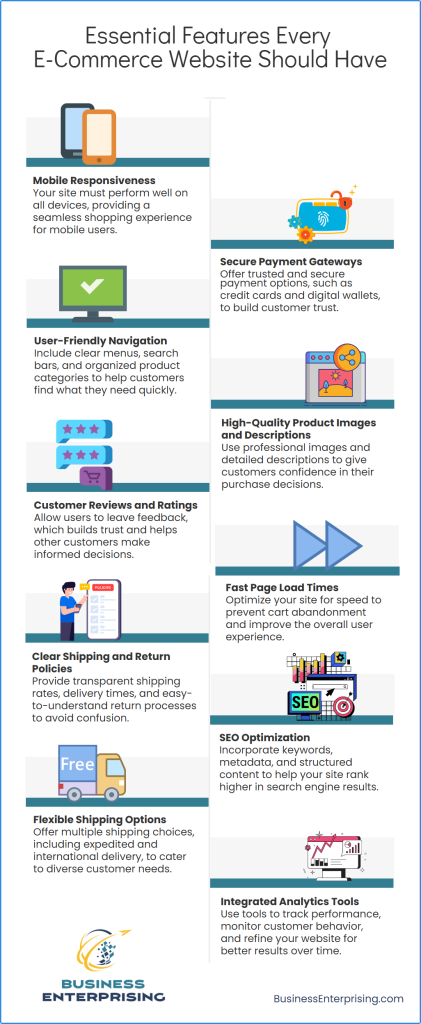
Additionally, every element of your website should work together to deliver a seamless shopping experience. From mobile responsiveness to secure payment options, these features help build trust and encourage conversions. By prioritizing the needs of your customers, you can create a site that stands out in a competitive market.
Understanding how to build and maintain a strong website is key to your e-commerce success. Therefore, focusing on design, performance, and customer engagement will set your business apart. With the right approach, your website can become a powerful tool for attracting and retaining loyal customers.
Choosing the Right E-Commerce Platform
Choosing the right e-commerce platform is a key decision for any startup. Each platform offers unique features and benefits. However, understanding your business needs will help you determine which platform is the best fit. Whether you prioritize ease of use, customization, or scalability, comparing popular platforms is a great place to start.
Shopify is a popular choice for websites for e-commerce startups due to its simplicity and extensive app store. It’s a hosted solution, so you won’t need to worry about managing technical aspects. Additionally, it offers a wide range of themes and plugins, which makes customization easy. However, it may not be ideal if you need full control over your website’s backend.
WooCommerce, on the other hand, is a flexible platform for those comfortable with WordPress. It’s open-source, which means you can fully customize your site. Additionally, it integrates well with WordPress plugins, making it highly adaptable. However, because it’s self-hosted, you’ll need to handle technical tasks like updates and security on your own.
BigCommerce provides robust features for startups focused on scalability. It offers built-in tools for SEO and marketing, making it ideal for growth-focused businesses. Additionally, it supports multiple sales channels, like Amazon and social media. However, its pricing may be higher compared to other platforms, especially for smaller startups.
Each platform has strengths and limitations, so evaluating your goals is essential. Consider your budget, technical expertise, and long-term growth plans before deciding. By selecting the right platform, you create a strong foundation for your e-commerce business to thrive.
Essential Features Every E-Commerce Website Should Have
Every successful e-commerce website shares a few essential features that enhance the user experience and build customer trust. Mobile responsiveness is one of the most important features to prioritize. With more customers shopping on their phones, your website must perform well on all devices. A responsive design not only improves user satisfaction but also helps your site rank better on search engines.
Secure payment gateways are another key feature for websites for e-commerce startups. Customers want to know their financial information is protected when shopping online. Therefore, integrating trusted payment processors and displaying security certifications builds credibility. Additionally, offering multiple payment options, such as credit cards and digital wallets, can accommodate a wider range of customers.
User-friendly navigation is just as critical. If customers can’t easily find products, they’re likely to leave your site. Clear menus, a well-organized layout, and a search bar make browsing effortless. Additionally, adding filters and categories can help customers locate specific items more quickly. By focusing on these features, you create an e-commerce website that’s functional, secure, and easy to use.
Designing a Website for Conversion
Designing a website for conversion requires careful attention to layout, product pages, and call-to-action elements. A clean, organized layout makes it easier for customers to browse and shop. However, cluttered designs can distract users and lead to abandoned carts. By keeping the layout simple and intuitive, you create a seamless shopping experience that encourages purchases.
Product pages are another critical factor for websites for e-commerce startups. High-quality images and detailed descriptions help customers make confident buying decisions. Additionally, including reviews and ratings builds trust and highlights the value of your products. Ensuring that your product pages load quickly also minimizes frustration and keeps users engaged.
Call-to-action elements, such as “Add to Cart” or “Buy Now” buttons, play a significant role in driving conversions. These buttons should be prominently displayed and easy to find. Additionally, using clear, action-oriented language helps guide customers through the purchase process. Strategically placing call-to-action elements throughout your site encourages users to take the next step. By focusing on these strategies, you can design a website that turns visitors into loyal customers.
Integrating Payment and Shipping Solutions
Integrating payment and shipping solutions is essential for creating a seamless customer experience. A simple, secure payment process builds trust and encourages sales. However, complicated payment systems can frustrate customers and lead to abandoned carts. By offering multiple payment options, such as credit cards and digital wallets, you make it easier for customers to complete their purchases.
Shipping options also play a significant role in customer satisfaction. Flexible choices, like expedited shipping or free delivery, cater to different needs and preferences. Additionally, providing clear shipping costs and delivery times upfront reduces confusion and builds transparency. When customers know what to expect, they’re more likely to complete their orders.
Websites for e-commerce startups should prioritize seamless integration of these solutions. Therefore, consider using tools that combine payment processing and shipping management into one system. This approach simplifies operations for you while improving the shopping experience for your customers. By focusing on these key areas, you create a website that fosters trust and encourages repeat business.
The Role of SEO in Driving Traffic to Your E-Commerce Website
The role of SEO in driving traffic to your e-commerce website is critical for increasing visibility. By optimizing your site for search engines, you improve its chances of ranking higher in search results. Higher rankings make it easier for potential customers to find your products. Additionally, SEO helps attract organic traffic, which can lead to more sales without requiring extra advertising costs.
Keyword research is a key part of SEO. Choosing relevant keywords allows you to target what your customers are searching for online. For example, optimizing product descriptions and blog content with these keywords can help improve your site’s visibility. However, overloading your content with keywords may harm your rankings, so focus on balance and quality.
Websites for e-commerce startups can benefit greatly from strong SEO practices. Optimizing site speed, mobile responsiveness, and metadata enhances user experience while boosting search engine rankings. Additionally, using backlinks and creating engaging content builds credibility and attracts more traffic. By making SEO an ongoing effort, you create a sustainable way to drive visitors to your site and grow your business.
Monitoring and Analyzing Website Performance
Monitoring and analyzing website performance is essential for maintaining a high-quality user experience. Tracking performance allows you to identify bottlenecks that could frustrate visitors. For example, slow-loading pages can lead to abandoned carts and lower sales. By addressing these issues promptly, you create a smoother browsing experience for your customers.
There are many tools available to help you track site performance. Analytics platforms can provide valuable insights into user behavior and page load times. Additionally, heatmaps can show where users interact most on your site, helping you refine layouts. Regularly reviewing this data allows you to make informed decisions about improvements.
Websites for e-commerce startups benefit greatly from consistent performance monitoring. For example, optimizing site speed and fixing broken links improve both usability and search engine rankings. Additionally, testing new features or layouts ensures they work as intended without disrupting the user experience. By using data-driven techniques, you can create a website that supports both growth and customer satisfaction.
Conclusion
Creating successful websites for e-commerce startups requires careful planning and consistent effort. Each decision you make shapes the user experience and influences your sales. However, focusing on essential elements like performance, design, and user engagement can help you build a site that drives results.
Additionally, staying adaptable is key to maintaining long-term success. Regularly monitoring and analyzing your website allows you to identify opportunities for improvement. Whether it’s optimizing site speed or refining product pages, small adjustments can make a significant impact over time. These efforts keep your website aligned with customer expectations and market trends.
Ultimately, the success of your e-commerce site depends on your ability to prioritize both functionality and user satisfaction. By combining data-driven strategies with thoughtful design, you can create a platform that supports growth and builds customer loyalty. Your website is more than just an online store; it’s a key tool for growing your business effectively.



